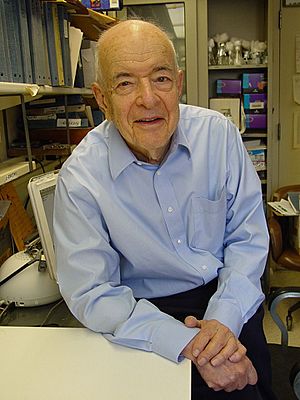Herbert Tabor facts for kids
Quick facts for kids
Herbert Tabor
|
|
|---|---|

Tabor in 2005
|
|
| Born | November 28, 1918 New York City, New York, U.S.
|
| Died | August 20, 2020 (aged 101) Bethesda, Maryland, U.S.
|
| Alma mater | Harvard University |
| Spouse(s) |
Celia White
(m. 1946; died 2012) |
| Children | 4 |
| Awards | William C. Rose Award (1995) |
| Scientific career | |
| Fields | Biochemistry |
| Institutions | National Institute of Diabetes and Digestive and Kidney Diseases |
Herbert Tabor (November 28, 1918 – August 20, 2020) was an American scientist. He was a biochemist, meaning he studied the chemistry of living things. He was also a physician-scientist, which means he was both a doctor and a researcher. Dr. Tabor focused on understanding how special chemicals called polyamines work in our bodies. He studied how these chemicals affect our health and diseases.
He worked at the National Institute of Diabetes and Digestive and Kidney Diseases (NIDDK). There, he was a main researcher, leading a lab that studied how medicines affect the body's chemistry. For many years, he was also the editor-in-chief of a major science magazine called the Journal of Biological Chemistry.
Contents
Early Life and Education
Herbert Tabor was born in New York City in 1918. He went to Harvard College and earned his first degree in 1937. Later, he studied at Harvard Medical School and became a doctor in 1941.
While in medical school, he also worked as a researcher. He studied how to measure blood volumes using a special method. He also completed an internship at Yale New Haven Hospital.
A Long Career in Science
Dr. Tabor worked at the National Institute of Diabetes and Digestive and Kidney Diseases (NIDDK) for a very long time. He was a main researcher there until 2020. From 1962 to 1996, he was the Chief of the Laboratory of Biochemical Pharmacology. This means he led a team that studied how chemicals affect living things.
When he passed away, Dr. Tabor had worked for the National Institutes of Health for 77 years. This was the longest time anyone had ever worked there!
From 1971 to 2010, Dr. Tabor was the editor-in-chief of the Journal of Biological Chemistry. This is a very important science magazine. Under his leadership, the number of articles published each year grew a lot. He also helped the magazine start publishing online in 1995.
Research on Polyamines
Dr. Tabor's main research was about polyamines. These are special chemicals that are important for human health and disease. His team studied how these chemicals are made and controlled inside living things. They often used tiny organisms like S. cerevisiae (a type of yeast) and E. coli (a type of bacteria).
Their research showed that polyamines are needed for these organisms to grow. They also help with making spores, protecting against damage, and keeping cells healthy in hot temperatures. Polyamines also help make sure proteins are built correctly and keep parts of the cell called mitochondria working.
Dr. Tabor's lab also created special versions of these organisms that made extra amounts of certain enzymes. Enzymes are like tiny tools that help chemical reactions happen. They studied the structure and control of these enzymes, like ornithine decarboxylase and spermidine synthase.
Awards and Recognition
Dr. Tabor was recognized for his important work. In 1977, he was chosen to be a member of the National Academy of Sciences. This is a very high honor for scientists in the United States.
In 1986, Dr. Tabor and his wife, Celia White Tabor, won the Hillebrand Prize. This award came from the Chemical Society of Washington. In 1995, they both received the William C. Rose Award.
Personal Life
Herbert Tabor married Celia White in 1946. She was also a physician-scientist. They met six years earlier on a streetcar in Boston.
In 1949, they moved to the campus of the National Institutes of Health (NIH). They raised their four children there: one daughter and three sons. Celia White Tabor passed away in 2012. Herbert Tabor died at his home on the NIH campus in August 2020.

